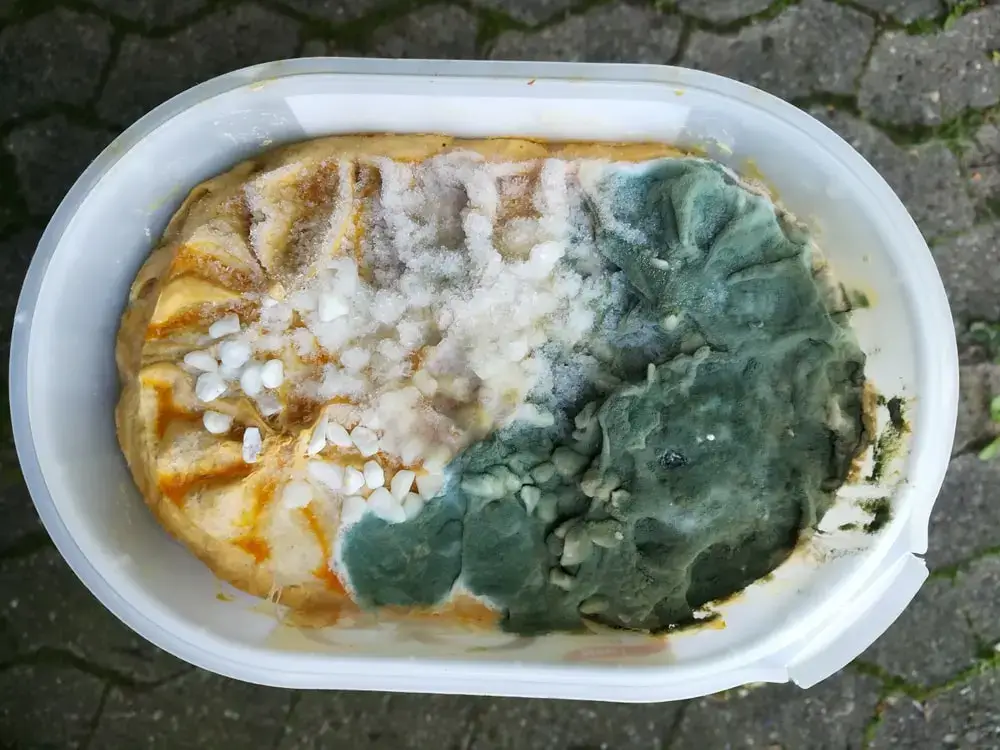Since childhood, many of us have harbored an obsession with ice cream, drawn to its smooth texture, the refreshing chill it offers, and the variety of flavors, from mint chip to cookie dough.
This fan-favorite treat is a staple in our diets, eagerly eaten every week throughout the hot summer days, thanks in part to the freezer which extends its lifespan.
However, the question “can ice cream get moldy?” introduces a complex issue.
Contrary to popular belief, ice cream can indeed become rancid and develop mold, challenging the notion that it lasts forever.
This misconception is untrue, as the incredibly hard to spot signs of mold—different from the noticeable fuzzy discoloration on items like bread and cheese—highlight the importance of knowing the signs of spoilage for our health.
Table of Contents
ToggleCan Ice Cream Get Moldy?
The impression that ice cream does not mold because it’s kept in the freezer is a common misconception.
However, once an opened box of ice cream is placed back in the freezer after being at room temperature for a few hours, the environment it was exposed to can encourage mold growth.
This mold may not appear as it does on other food items, but can manifest as gooey, tiny ice shards strewn throughout, altering the texture and appearance in a not so appetizing way.
How Long Does Ice Cream Take To Mold?
Usually, mold on ice cream is not as visible as on other types of food.
It’s essential to be extremely careful with ice cream that has melted and then been refrozen; this is often the biggest mistake people make.
It only takes about two hours for bacteria to start spreading across the whole ice cream, increasing the chance of mold growing without being noticed.
Larger containers and boxes of ice cream left at room temperature for too long can become a breeding ground for bacteria, potentially leading to harmful diseases and illnesses.

How To Tell If Ice Cream Is Bad?
Determining if ice cream has gone bad can be challenging, but there are three key indicators of spoilage to look for.
Its fairly long shelf life in the freezer can be deceptive, making it important to stay vigilant over time and storing conditions.
-
Appearance Of Ice Shards
Freezer burn manifests as tiny ice shards on the top of the ice cream and the lid.
If you notice these, it’s a sign that the quality has deteriorated, and the flavor and texture won’t be as desirable as in the beginning.
It’s safe, but not good; opting for a fresh pint might be better.
-
Texture Changes
Pay extra close attention to the texture of your ice cream. If it’s anything but smooth and creamy, it has likely gone bad.
A gooey, goopy, or slimy appearance is a clear sign that your ice cream should not be eaten.
-
Off-Putting Smell
Ice cream, like any other food item in your kitchen, can show signs of spoilage through its smell.
If it doesn’t smell sweet and inviting but rather musty and stale, it’s off. In such cases, consider buying fresh ice cream or making your own.
-
Change In Color
While the ice cream is available in several colors and flavors, any drastic change in color, particularly discoloration or darkening, could suggest that it is no longer safe to consume.
-
Unusual Taste
If you taste ice cream and notice an off or odd taste, it clearly indicates that it has spoiled and should be discarded.
-
Expired “Best By” Date
Check the “best by” date on ice cream packaging. If the date has passed, it may still be safe to consume, but its quality may have declined.
-
Mold Growth
Rarely ice cream can grow mold on its surface, particularly if exposed to mold spores before freezing or kept in inappropriate conditions.
What Does Mold On Ice Cream Look Like?
Identifying mold on ice cream can be tricky, especially since changes in its texture are the primary indicator.
Mold can transform the original creamy texture into a mixture of gooey and small ice shards, which might not be immediately visible.
A careful and attentive examination is required to detect these changes, and a significant alteration in smell can also be a sign that the ice cream has gone bad.
Always check twice before eating your sweet frozen dessert.
How Long Does Ice Cream Last?
How long does ice cream last depends on a few factors, such as whether it is homemade or store-bought, and how it is stored.
For store-bought ice cream, you may have noticed that it comes with a “sell by” or “best by” date on the container.
This date is an excellent indicator of when it is anticipated to be at its absolute best regarding texture and flavor.
If you keep store-bought ice cream appropriately stored in the freezer at a consistent temperature of 0°F or below, it can maintain its quality for about 2-4 months beyond the printed date.
Homemade ice cream might have a shorter shelf life due to variations in ingredients and preparation techniques.
With time, ice cream can become freezer burnt or develop ice crystals, which can impact its flavor and texture.
To increase its shelf life, ensure to keep ice cream container tightly sealed to inhibit exposure to moisture and air because these factors can accelerate freezer burn.
Discarding it after four months is recommended instead of risking your health.
Is It Bad To Eat Expired Ice Cream?
The expiration date on ice cream refers mainly to food quality, and not necessarily to it being bad after it passes.
However, once the box has been opened, the risk of spoilage increases.
Ice cream is particularly delicate and vulnerable to mold and bacteria contamination, especially when temperature changes occur from the freezer to room temperature.
If mold is noticed, it’s safer to rid yourself of the frozen dessert.

What Happens If You Eat Moldy Ice Cream?
Consuming moldy ice cream can harm your health and can lead to many negative effects. Mold is a type of fungus that generates mycotoxins, which can be toxic to humans.
When you eat mold or food contaminated with mold, you risk ingesting these harmful substances.
The mycotoxins created by mold can cause various health issues, particularly if consumed in large amounts or over a prolonged duration. Some common symptoms of eating moldy food may include:
Stomach Upset: You might experience nausea, vomiting, or diarrhea.
Allergic Reactions: It can trigger allergic reactions in some folks, leading to symptoms such as sneezing, coughing, wheezing, or skin rashes.
Respiratory Problems: Inhaling or ingesting mold spores can irritate your respiratory system, particularly if you have existing respiratory conditions like asthma.
Headaches: Mold exposure can cause headaches or migraines in some individuals.
Fatigue: You may feel unusually tired or fatigued.
Digestive Issues: Mold can disturb your gut health and lead to digestive problems.
How To Store Ice Cream?
Storing ice cream properly in the freezer can significantly prolong its lifespan and deter the formation of ice crystals.
Keep the freezer at 0F or below, avoiding temperature changes by not storing it in the side door and keeping the door closed as much as possible.
Wrap the container with plastic wrap before placing the lid on to lock in flavor and quality.
-
Wrap Before Storing
Whether it’s store-bought or homemade ice cream, always wrap the container with plastic wrap before securing the lid.
This creates an added barrier against air and moisture, preserving the flavor and quality of your ice cream.
-
Select A Deep Freeze
Store it in your freezer’s coldest part, ideally at a temperature of 0°F (-18°C) or lower.
A deep freezer with a consistent temperature is preferable because temperature changes can lead to ice crystals’ formation and affect ice cream’s quality.
-
Keep Original Packaging
If your ice cream is still in its actual packaging, try to keep it in that packaging.
Commercial ice cream containers are designed to safeguard the product from temperature fluctuations and air exposure.
-
Use Airtight Containers For Homemade Ice Cream
For homemade ice cream, which lacks preservatives and is more prone to becoming rancid, storing it in an airtight container is crucial.
Wrap the top of the container before applying the lid to ensure it remains in tip-top shape.
Plus, you can put a layer of plastic wrap directly on ice cream’s surface before sealing the box to generate a barrier against air exposure.
-
Keep Away From Strong Fragrances
Ice cream can absorb fragrances from other foods in the freezer, impacting its flavor.
Store it away from strong-smelling foods to inhibit flavor contamination.
-
Avoid Repeatedly Thawing And Refreezing
Frequently thawing and refreezing ice cream can lead to ice crystals’ formation and degrade its quality.
Try to remove only the amount you want to eat, and don’t let the ice cream soften and refreeze.
-
Limit Air Exposure
Air exposure can cause freezer burn and affect the taste and texture of ice cream. Always seal the box tightly to reduce air contact.
This is especially vital if you have removed a portion and are returning the box to the freezer.
-
Rotate Stock
If you have several ice cream containers, try to eat the older ones first. This guarantees you are always enjoying ice cream at its finest quality.
-
Organize Appropriately
Keep your freezer organized so the ice cream is effortlessly accessible and not buried beneath other things.
This lowers the amount of time the freezer door is open, aiding in maintaining a consistent temperature.

Frequently Asked Questions
-
How Long Can Ice Cream Last In The Freezer?
Ice cream can last a long time in the freezer, especially when kept at 0F. The longevity of ice cream changes depending on whether it’s unopened or opened, and if it’s store-bought or homemade. Unopened ice cream can last months past its best by date, while opened ice cream and homemade ice cream have shorter lifespans.
-
Can Ice Cream Mold In The Freezer?
Ice cream’s ingredients can become moldy, although mold does not typically develop below the freezing point. However, if not stored appropriately, mold from before freezing can persist.
-
Does Ice Cream Catch Fungus?
Moldy conditions can occur in ice cream if it thrives in damp, warm environments but is not stored or handled correctly, even though it’s frozen.
-
Can Bacteria Survive In Ice Cream?
According to studies, probiotic bacteria can survive in ice cream for up to six months in freezing conditions and stay above the recommended minimum limit of 106CFU/g.
-
Can You Get Food Poisoning From Refrozen Ice Cream?
Refreezing ice cream, especially after it’s been left out on the counter for over two hours, can lead to food poisoning. It’s not recommended to re-freeze it.
-
What Happens If You Eat Moldy Ice Cream?
If you eat moldy ice cream, it’s unlikely to make you sick unless you’re allergic to mold or ingest toxic substances like mycotoxins, which can cause symptoms from vomiting to feeling unwell or in extreme cases, death.
-
Can I Eat Ice Cream Left Out Overnight?
Eating ice cream that’s been left out overnight is not recommended. Even in low and cold temperatures outside, it doesn’t match the freezer’s conditions, raising the possibility of bacteria spreading and food poisoning.
-
Why Is My Ice Cream Slimy?
Sliminess in ice cream is an indicator that it has gone rancid. Throw it out ASAP.
-
Will Old Ice Cream Make You Sick?
Eating moldy ice cream can lead to sickness, with symptoms like nausea, vomiting, stomachache, and diarrhea. Severe cases should be diagnosed and treated by a professional.
-
Can Ice Cream Go Bad In The Fridge?
Yes, ice cream can go bad in the fridge much more quickly than in the freezer. It’s recommended to always store it at temperatures below 0F.
Conclusion
So, can ice cream get moldy? Surprisingly, it can and will get moldy with time, particularly if you leave it at room temperature for more than 2 hours and refreeze it. The signs of mold include gooeyness, odd smell, ice shreds, and sliminess. If you witness mold on ice cream, avoid consuming it.
You May Also Like To Check Out
- Oreos Without Cream: Do They Sell Them And Where To Buy Them
- 10 Expert-Approved Methods For How To Prolong Food Shelf Life
- How To Store Zucchini Bread And Keep It Moist For Days
- How To Throw A Dinner Party At Home For Adults
- 5 Creative Ways How To Make Breadcrumbs Without A Food Processor
- How Long Do Homemade Chocolate Chip Cookies Last
- 5 Easy Ways To Eat Healthy On A Budget
- How To Harden Soft Cookies
- Can We Drink Milk During Periods
- What To Bake For A Party
- How To Stop Craving For Junk Food











